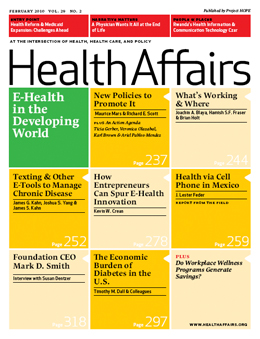 As we journey through the health IT “gold rush,” what do we know we know about health information technology that can help us smooth the ride? That’s the theme of the April 2010 issue of Health Affairs, and the issue offers a rich compendium of learnings.
As we journey through the health IT “gold rush,” what do we know we know about health information technology that can help us smooth the ride? That’s the theme of the April 2010 issue of Health Affairs, and the issue offers a rich compendium of learnings.
Two HIT David’s, Blumenthal and Brailer, dialogue about health IT policy in the larger context of health policy overall. Brailer points to ARRA’s health IT stimulus funding in the HITECH Act as one of the spectacular events in the history of health policy which changed the world of health information technology overnight. Dr. Blumenthal emphasizes the importance of incorporating payment reform into the mix: specifically, paying-for-performance to drive quality up and cost down. He says, The purpose of health information technology is to support health reform, and it is part of that larger puzzle. It is not a stand-alone goal or an end in itself. But health IT enables P4P, and Dr. Blumenthal insists that HIT is a fundamental tool for modern health care practice. In their discussion of meaningful use, Dr. B observes that the incentives for providers’ HIT adoption are front-loaded, to incent positive behaviors early in the process. He describes this challenge as “the escalabor problem.” Once incentives get providers moving onto the escalator after year one, in year two more challenging meaningful use is required: will providers want to jump off? There will be a balance in defining meaningful use going up the four-year ladder of incentives. More of the conversation covers privacy, state information exchanges, and international lessons learned.
A major theme of the columns is that buying and implementing a new HIT system won’t automatically enhance quality of care. Success is all about the full implementation and cultural commitment of the organization that’s using the system. Case studies from two hospital systems, Mass General and the University of Minnesota, highlight this challenge. In another clinical setting, a patient-centered medical home, the practice found that adopting an EHR wasn’t a magic bullet for them, either: their project yielded medication errors and interruptions in physician workflow that compromised the practice. For small practices, the NCQA is recommending that clinicians reduce their workloads when implementing EHR systems for a period of one to three months.
Group Health Cooperative in Seattle raised an issue near-and-dear to the heart of Health Populi: that health citizens/consumers should be part of meaningful use criteria. This is a very digital health system: nearly one-third of Group Health’s patient visits were done through a secure e-mail messaging system in 2009; 10% of patients reviewed lab tests online, and 10% of patients refilled meds online. By the end of 2009, 58% of the plan’s patients accessed EHRs.

Steve Lieber, head of HIMSS which is the HIT industry’s major advocacy group, notes that since the advent of ARRA and the HIT stimulus promise of $20 billion, HIT sales have not dramatically upticked. Even with mass adoption, health IT is a platform for change but not in and of itself 100% of the solution for solving all of America’s health care ills.
The bottom-line of this important issue of Health Affairs is that health information technology isn’t a panacea for solving health care’s cost and quality problem in the U.S. We should expect a lot of heavy lifting when it comes to implementing the systems, measuring meaningful use, interrupting clinical workflows in doctors’ offices, and achieving the returns-on-investment that HIT vendors are promising. This is certainly a marathon, not a sprint — but eventually, American health citizens will be better off in terms of health care quality, outcomes, and rational spending on health services and products.




 Thanks to Feedspot for naming this blog, Health Populi, as a
Thanks to Feedspot for naming this blog, Health Populi, as a